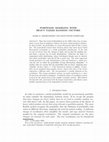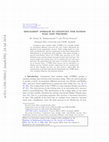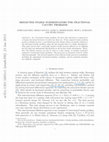Papers by Mark Meerschaert

Water Resources Research, 2008
1] In networks where individual fracture lengths follow a fractal distribution, ensemble transpor... more 1] In networks where individual fracture lengths follow a fractal distribution, ensemble transport of conservative solute particles at the leading plume edge exhibit characteristics of operator-stable densities. These densities have, as their governing equations of transport, either fractional-order or integer-order advection-dispersion equations. Model selection depends on the identification of either multi-Gaussian or operator-stable transport regimes, which in turn depends on the power law exponent of the fracture length distribution. Low to moderately fractured networks with power law fracture length exponents less than or equal to 1.9 produce solute plumes that exhibit power law leading-edge concentration profiles and super-Fickian plume growth rates. For these network types, a multiscaling fractional advection-dispersion equation (MFADE) provides a model of multidimensional solute transport where different rates of power law particle motion are defined along multiple directions. The MFADE model is parameterized by a scaling matrix to describe the super-Fickian growth process, in which the eigenvectors correspond to primary fracture group orientations and the eigenvalues code fracture length and transmissivity. The approximation of particle clouds by a multi-Gaussian (a subset of the operator stable) for densely fractured networks with finite variance fracture length distributions can be ascribed to the classical ADE where Fickian scaling rates pertain along orthogonal plume growth directions. Fracture networks show long-term particle retention in low-velocity fractures so that coupling of the equations of motion with retention models such as continuous time random walk or multirate mobile/immobile will increase accuracy near the source. Particle arrival times at exit boundaries for multi-Gaussian plumes vary with spatial density. Generally, arrival times are faster in sparsely fractured domains where transport is governed by a few very long fractures. Citation: Reeves, D. M., D. A. Benson, M. M. Meerschaert, and H.-P. Scheffler , Transport of conservative solutes in simulated fracture networks: 2. Ensemble solute transport and the correspondence to operator-stable limit distributions, Water Resour. Res., 44, W05410,

Water Resources Research, 2006
The creation of representative aquifer facsimiles is the cornerstone of Monte Carlo stochastic hy... more The creation of representative aquifer facsimiles is the cornerstone of Monte Carlo stochastic hydrology. This process hinges on the identification and recreation of the statistical properties (distribution and correlation) of aquifer properties such as hydraulic conductivity (K). Since aquifers may have structures present across a huge range of scales, the concepts of fractional Brownian motion (fBm) have been explored previously in both analytic and numerical stochastic settings. The previous models have used isotropic scaling, in which the self-similarity properties do not vary with direction. Any anisotropy has been handled by a simple (elliptical) stretching of the scalar random K field. We define an extension of fBm to d−dimensions in which the fractionalorder integration in fBm may take on different orders in the d primary scaling directions (which do not have to be orthogonal) and the weight of the integration (correlation) is freely assigned according to a discrete or continuous measure on the unit sphere. This approach accounts for the different scaling found in the vertical versus horizontal in real granular aquifers. It also allows a description of fracture networks in a continuum setting: non-orthogonal eigenvectors describe the primary scaling directions, and discrete weight of fractional integration represent fracture continuity that is limited to a small number of directions. In a numerical experiment of a granular aquifer, the motion of solute in an operational-fractional Gaussian field depends very much on both the longitudinal and the transverse scaling (Hurst) coefficients. Lower integration order in the transverse direction (in the range of fractional Gaus-D R A F T June 2, 2004, 6:25pm D R A F T BENSON ET AL.: OPERATOR-FRACTIONAL FIELDS X -3

Handbook of Heavy Tailed Distributions in Finance, 2003
Since the work of Mandelbrot in the 1960's there has accumulated a great deal of empirical eviden... more Since the work of Mandelbrot in the 1960's there has accumulated a great deal of empirical evidence for heavy tailed models in finance. In these models, the probability of a large fluctuation falls off like a power law. The generalized central limit theorem shows that these heavy-tailed fluctuations accumulate to a stable probability distribution. If the tails are not too heavy then the variance is finite and we find the familiar normal limit, a special case of stable distributions. Otherwise the limit is a nonnormal stable distribution, whose bell-shaped density may be skewed, and whose probability tails fall off like a power law. The most important model parameter for such distributions is the tail thickness α, which governs the rate at which the probability of large fluctuations diminishes. A smaller value of α means that the probability tails are fatter, implying more volatility. In fact, when α < 2 the theoretical variance is infinite. A portfolio can be modeled using random vectors, where each entry of the vector represents a different asset. The tail parameter α usually depends on the coordinate. The wrong coordinate system can mask variations in α, since the heaviest tail tends to dominate. A judicious choice of coordinate system is given by the eigenvectors of the sample covariance matrix. This isolates the heaviest tails, associated with the largest eigenvalues, and allows a more faithful representation of the dependence between assets.

The Annals of Probability, 2014
Continuous time random walks (CTRWs) are versatile models for anomalous diffusion processes that ... more Continuous time random walks (CTRWs) are versatile models for anomalous diffusion processes that have found widespread application in the quantitative sciences. Their scaling limits are typically non-Markovian, and the computation of their finite-dimensional distributions is an important open problem. This paper develops a general semi-Markov theory for CTRW limit processes in R d with infinitely many particle jumps (renewals) in finite time intervals. The particle jumps and waiting times can be coupled and vary with space and time. By augmenting the state space to include the scaling limits of renewal times, a CTRW limit process can be embedded in a Markov process. Explicit analytic expressions for the transition kernels of these Markov processes are then derived, which allow the computation of all finite dimensional distributions for CTRW limits. Two examples illustrate the proposed method. . This reprint differs from the original in pagination and typographic detail. 1 2 M. M. MEERSCHAERT AND P. STRAKA
Communications in Applied and Industrial Mathematics, 2014
The Annals of Statistics, 1997
In this paper we establish the basic asymptotic theory for periodic moving averages of i.i.d. ran... more In this paper we establish the basic asymptotic theory for periodic moving averages of i.i.d. random variables with regularly varying tails. The moving average coefficients are allowed to vary according to the season. A simple reformulation yields the corresponding results for moving averages of random vectors. Our main result is that when the underlying random variables have finite variance but infinite fourth moment, the sample autocorrelations are asymptotically stable. It is well known in this case that sample autocorrelations in the classical stationary moving average model are asymptotically normal.
Water Resources Research, 2001
A mathematical method called subordination broadens the applicability of the classical advection-... more A mathematical method called subordination broadens the applicability of the classical advection-dispersion equation for contaminant transport. In this method the time variable is randomized to represent the operational time experienced by different particles. In a highly heterogeneous aquifer the operational time captures the fractal properties of the medium. This leads to a simple, parsimonious model of contaminant transport that exhibits many of the features (heavy tails, skewness, and non-Fickian growth rate) typically seen in real aquifers. We employ a stable subordinator that derives from physical models of anomalous diffusion involving fractional derivatives. Applied to a onedimensional approximation of the MADE-2 data set, the model shows excellent agreement.
First-order transfer of mobile solute into an immobile phase results in a time-nonlocal governing... more First-order transfer of mobile solute into an immobile phase results in a time-nonlocal governing equation of motion. In a Lagrangian sense, this is also a definition of a continuous time random walk. Under certain circumstances, the two approaches are equivalent. If the random time spent in an immobile state has finite mean, then the transport eventually converges to a local
A time and space fractional advection dispersion equation (ADE) has been shown to be the limiting... more A time and space fractional advection dispersion equation (ADE) has been shown to be the limiting equation governing continuous time random walks (CTRWs) with heavy-tailed waiting times and heavy-tailed jump lengths. This equation provides a useful model of total (mobile + immobile) solute transport in aquifers; a particle can move through the aquifer with groundwater or be motionless due to
For more than a decade, fractional advection-dispersion equations (fADE) have been used to model ... more For more than a decade, fractional advection-dispersion equations (fADE) have been used to model super- and sub-diffusive motion in a variety of geologic systems. Applications include solute transport in aquifers and streams, sediment transport in rivers and on hillslopes, as well as surface fluctuations during deposition and erosion. The close relationship between fractional diffusion and a family of probability models
Extreme value theory is used to predict the recurrence of extreme geologic events and is a key fa... more Extreme value theory is used to predict the recurrence of extreme geologic events and is a key factor in risk mitigation. Stochastic representation of both annual and partial duration series is typically based on the Poisson process. Maxima, minima, and threshold exceedances are represented by a best-fit probability distribution but are assumed to be separated by fixed or exponentially distributed
Classical and anomalous diffusion equations employ integer derivatives, fractional derivatives, a... more Classical and anomalous diffusion equations employ integer derivatives, fractional derivatives, and other pseudodifferential operators in space. In this paper we show that replacing the integer time derivative by a fractional derivative subordinates the original stochastic solution to an inverse stable subordinator process whose probability distributions are Mittag-Leffler type. This leads to explicit solutions for space-time fractional diffusion equations with multiscaling space-fractional derivatives, and additional insight into the meaning of these equations.

Transactions of the American Mathematical Society, 2015
In a fractional Cauchy problem, the first time derivative is replaced by a Caputo fractional deri... more In a fractional Cauchy problem, the first time derivative is replaced by a Caputo fractional derivative of order less than one. If the original Cauchy problem governs a Markov process, a non-Markovian time change yields a stochastic solution to the fractional Cauchy problem, using the first passage time of a stable subordinator. This paper proves that a spectrally negative stable process reflected at its infimum has the same one dimensional distributions as the inverse stable subordinator. Therefore, this Markov process can also be used as a time change, to produce stochastic solutions to fractional Cauchy problems. The proof uses an extension of the D. André reflection principle. The forward equation of the reflected stable process is established, including the appropriate fractional boundary condition, and its transition densities are explicitly computed.

IEEE Journal on Emerging and Selected Topics in Circuits and Systems, 2013
ABSTRACT In this paper, a new fractional order generalization of the diffusion equation is develo... more ABSTRACT In this paper, a new fractional order generalization of the diffusion equation is developed to describe the anisotropy of anomalous diffusion that is often observed in brain tissues using magnetic resonance imaging (MRI). The new model embeds three different fractional order exponents-corresponding to the principal directions of water diffusion-into the governing Bloch-Torrey equation. The model was used to analyze diffusion weighted MRI data acquired from a normal human brain using a 3T clinical MRI scanner. Analysis of the data revealed normal Gaussian diffusion in the cerebral spinal fluid (isotropic fractional order exponent of (0.90 ±0.1), and anomalous diffusion in both the white (0.67 ±0.1) and the gray (0.77 ±0.1) matter. In addition, we observed anisotropy in the fractional exponent values for white mater (0.59 ±0.1) along the fibers versus 0.68 ±0.1 across the fibers), but not for gray matter. This model introduces new parameters to describe the complexity of the tissue microenvironment that may be sensitive biomarkers of the structural changes arising in neural tissues with the onset of disease.

Geophysical Monograph Series, 2000
It is increasingly apparent that sediment property distributions on sufficiently small scales are... more It is increasingly apparent that sediment property distributions on sufficiently small scales are probably irregular. This has led to the development of stochastic theory in subsurface hydrology, including statistically heterogeneous concepts based mainly on the Gaussian and Lévy-stable probability density functions (PDFs), the mathematical basis for stochastic fractals. Gaussian and Levy-stable stochastic fractals have been applied both in the field of turbulence and subsurface hydrology. However, measurements have shown that the increment frequency distributions do not always follow Gaussian or Lévy-stable PDFs. Provided herein is an overview of the origin and development of a new non-stationary stochastic process, called fractional Laplace motion (flam) with stationary, correlated, increments called fractional Laplace noise (fLan). It is based on the Laplace PDF and known generalizations, and does not display self-similarity. Uncorrelated versions are equivalent to a Brownian motion subordinated to the gamma process. In analogy to the development of fractional Brownian motion (fBm) from Brownian motion, fLam is equivalent to fBm subordinated to a gamma process. The new stochastic fractal has increment PDFs that compare better with measurements, the moments of the PDF family remain bounded, and decay of the increment distribution tails vary from being slower than exponential through exponential and on to a Gaussian decay as the lag size increases. This leads to increasingly more intermittent fluctuations as the lag size decreases. It may be that the geometric central limit theorem, and possible generalizations, will play an important role in connecting the abstract mathematics to the physics underlying applications. 1 1. HISTORICAL OVERVIEW
Journal of vibration and acoustics, 2014
This paper develops new fractional calculus models for wave propagation. These models permit a di... more This paper develops new fractional calculus models for wave propagation. These models permit a different attenuation index in each coordinate to fully capture the anisotropic nature of wave propagation in complex media. Analytical expressions that describe power law attenuation and anomalous dispersion in each direction are derived for these fractional calculus models.
Physical review. E, Statistical physics, plasmas, fluids, and related interdisciplinary topics, 1999
Extension of the fractional diffusion equation to two or three dimensions is not as simple as ext... more Extension of the fractional diffusion equation to two or three dimensions is not as simple as extension of the second-order equation. This is revealed by the solutions of the equations: unlike the Gaussian, the most general stable vector cannot be generated with an atomistic measure on the coordinate axes. A random combination of maximally skewed stable variables on the unit sphere generates a stable vector that is a general model of a diffusing particle. Subsets are symmetric stable vectors that have previously appeared in the literature and the well-known multidimensional Brownian motion. A multidimensional fractional differential operator is defined in the process.

Physical review. E, Statistical, nonlinear, and soft matter physics, 2001
The long-term limit motions of individual heavy-tailed (power-law) particle jumps that characteri... more The long-term limit motions of individual heavy-tailed (power-law) particle jumps that characterize anomalous diffusion may have different scaling rates in different directions. Operator stable motions [Y(t):t> or =0] are limits of d-dimensional random jumps that are scale-invariant according to c(H)Y(t)=Y(ct), where H is a dxd matrix. The eigenvalues of the matrix have real parts 1/alpha(j), with each positive alpha(j)< or =2. In each of the j principle directions, the random motion has a different Fickian or super-Fickian diffusion (dispersion) rate proportional to t(1/alpha(j)). These motions have a governing equation with a spatial dispersion operator that is a mixture of fractional derivatives of different order in different directions. Subsets of the generalized fractional operator include (i) a fractional Laplacian with a single order alpha and a general directional mixing measure m(straight theta); and (ii) a fractional Laplacian with uniform mixing measure (the Riesz ...
Dispersion in Heterogeneous Geological Formations, 2001
... 212 DAVID A. BENSON ET AL. of the central limit theorem (CLT). ... Benson (1998) showed that ... more ... 212 DAVID A. BENSON ET AL. of the central limit theorem (CLT). ... Benson (1998) showed that the second-order advection dispersion equation (ADE), even in a nonlinear form with the space-dependent dispersion tensor, cannot generally predict the stable Lévy motions. ...




Uploads
Papers by Mark Meerschaert